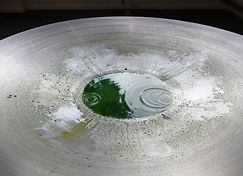PERADAM PROJECTS

SLOW MELT
SLOW MELT was an ephemeral site specific installation made for The Warming, in which a new set of 26 rock forms made from ice and deriving their colour from a different freshwater system, were suspended each morning to thaw and flow out onto the street by days end.
The suspension points in the disc above were made by selecting 26 stars from the Southern Celestial Sphere, that is the sky one would see if standing right on the South Pole. This refers to the Melankovitch cycles that measure the effects of orbital precession, axial tilt and eccentricity, on climate over tens of thousands of years. Below the sky disc the rocks began their melt within minutes of being hung, losing their surface complexity in less than an hour and their entire volume over the course of the day. The sublime and luminous became abject, reduced to a slow trickle on the pavement outside the building.
The metranomic dripping of the melting ice rocks signified both transformation and inexorable loss. Every so often over the course of the melt, the looping threads within a particular rock would unravel, causing it to tremble and drop, evoking the random nature of a tipping point. Eventually the remaining pebbles would sheer off and hit the metal disc below.
Each set derived it's 'chroma' from a particular waterway or aspect of the cryosphere researched by the artists. Some sets reflected the qualities of pristine waters, and others documented toxic spills such as cyanobacteriabloom, or cryconite deposits in the ice sheet. Some waters were collected and two local waterways were documented in collaboration with other artists: Rebecca Mayo made a set of rocks from Golden Willow collected along the Merri Creek, and Laura Power Davies made the dyes for the Stony and Kororoit Creeks from eucalyptus and peppercorn leaves and flowers.
Water is vital for life and dynamic in shaping topography.
From global to local, climatic shifts are slow, steady and significant. In choosing ice as our medium we brought ourselves into an absurd daily battle against both time and temperature. The attempt to make a beautiful object that would survive long enough to be seen became a metaphor for the effort to preserve the remaining wilderness and ecosystems on Earth. Our research sensitised us to the beauty in the world.
We would like to thank John Hand from Melbourne Polytechnic for assisting us with this project, Geoff Tobias from Whitehorse Industries, Guy Abrahams and Bronwyn Johnson from ClimARTe, curator Mandy Martin and Stuart Purves, Director of Australian Galleries.
Heather Hesterman and Sarah Tomasetti
Slow Melt was a chromatic documentation of the following locations and phenomena from the 3rd to the 24th of May 2015
3 May Lynch Glacier, Washington State, USA.
Chlamydomonas nivalis or ‘Watermelon Snow’ and glacial melt water.
4 May Wilsons Promontory, Victoria, Australia.
5 May Ice Sheet, Antarctica. Cryconite deposits and glacial melt water.
6 May Tasman Glacier, New Zealand. Rock, ice and glacial melt water.
7 May Spirulina harvest. Myanmar.
8 May Merri Creek, Victoria, Australia. Waters collected from Merri Creek.
9 May Five Flowers Lake. Jiuzhiaghou Valley, Tibet.
10 May Yangtze River, China. Dye dump near Chongqing.
11 May Lake Baikal, Siberia, Russia. Seasonal waters and ice.
12 May Lake Erie, Great Lakes, North America. Cyanobacteria blooms caused by fertilizer runoff.
13 May Lake Tekapo, New Zealand.
14 May Ganges River, Varanasi, Uttar Pradesh, India.
15 May Merri Creek, Victoria, Australia. Golden Willow (hybrid between Salix babylonica & Salix alb var.vitellina) dyes prepared by artist Rebecca Mayo.
16 May Snowy River, Victoria and New South Wales, Australia.
17 May Yukon River, Alaska, USA.
18 May Murray River, South Australia.
19 May Mekong Delta, Vietnam.
20 May Stony Creek and Kororoit Creek, Victoria, Australia. Dyes from indigenous and exotic plant species: prepared by artist Laura Power-Davies.
21 May Ephemeral Desert Lakes, South Australia.
22 May Amazon River, Brazil. From Mismi to the Atlantic Ocean.
23 May Cano Cristales, Colombia. Seasonal red caused by Macarenia clavigera
24 May Franklin River, Tasmania, Australia.